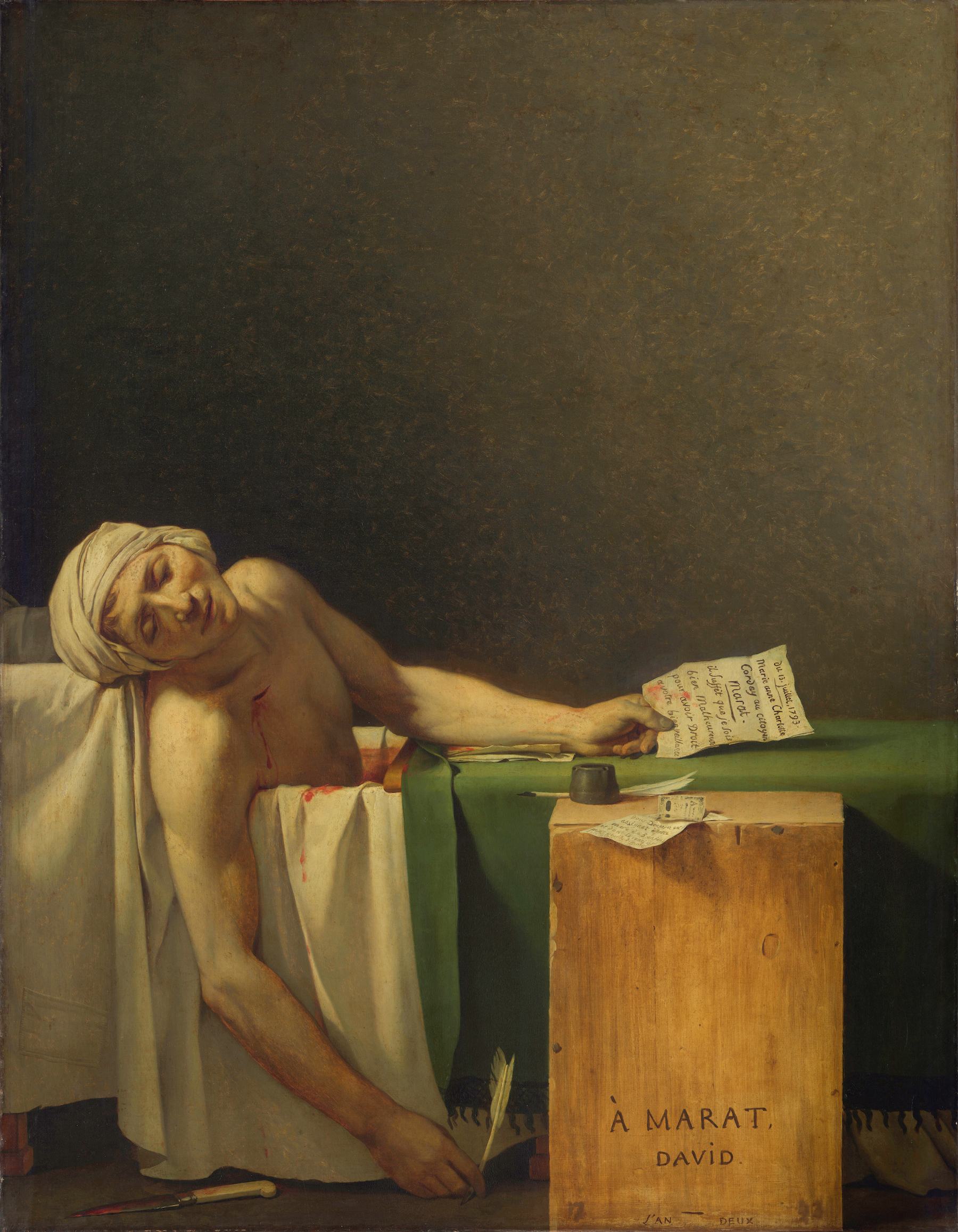
In 1793, Jacques Louis David, the official artist of the French Revolution, painted the Death of Marat as a tribute to his slain friend, the revolutionary propagandist Jean-Paul Marat, in the wake of his assassination. The painting, which is today in the Museum of Fine Arts in Brussels, remains one of the defining images of that era. Most museum goers are at least cursorily familiar with the image and the story behind it.
So you probably know that the assassination in question took place during the Reign of Terror in the French Revolution, and that David’s depiction was used as Jacobin propaganda. You may know that Marat was killed by one Charlotte Corday, who gained entrance to his house by promising to give Marat dirt on enemies of the Revolution, then stabbed him. You may know that Marat is pictured in a bath tub because he had a skin condition that he was treating, and that the note shown gripped in his hand is meant as evidence of Corday’s trickery, showing a message from her asking for his help.
Here are three facts about the painting that go a little deeper.
1) It May Be His Tribute to Another Revolutionary as Well: Caravaggio
Caravaggio, Entombment of Christ (1603). Collection of the Vatican Museum.
You may not think of austere Neoclassicism as connected to the bombastic Baroque. But scholars have called the Death of Marat David’s “most intense masterpiece of Caravaggism.”
As a student, David was likely very inspired by Caravaggio, who was not the most fashionable reference in France at the time. With its draped arm and stigmata-like, bloodless wound, the figure in Death of Marat echoes Caravaggio’s Entombment of Christ (1603). Marat’s dramatically lit, slack-jawed face also echoes Caravaggio’s Mary Magdalen in Ecstasy (1610).
Caravaggio, Mary Magdalen in Ecstasy (1610). Image via Wikimedia Commons.
The French Revolution rebelled against the church, and thus made religious iconography forbidden during this period. But the reference to Caravaggio’s works helped David render Marat a Revolutionary martyr. Since Marat’s newspaper was called “The Voice of the People,” and Caravaggio was famous (or infamous) for inserting images of the common people into Biblical scenes, the influence really makes sense.
2) Corday, Not Marat, Would be Celebrated in Art for Decades After ‘The Death of Marat’
Jean-Jacques Hauer, Charlotte Corday (1793). Courtesy of Wikimedia Commons.
Charlotte Corday, the assassin, is not depicted in David’s picture, which is part of what gives Marat’s figure its beautified, otherwordly status. During her trial, an unrepentant Corday stated she had acted to stop Marat from further fueling the Reign of Terror, saying, “I have killed one man to save a hundred thousand,” before being sent to the guillotine.
Corday’s dying wish was that her portrait be taken. National Guard officer Jean-Jacques Hauer, who had already taken some sketches of the prisoner, created her likeness in the hours just before her execution.
In the decades that followed, opinion on the Revolution turned, and so did opinions on the Death of Marat. David had to have the painting hidden away when he was exiled to Brussels. Meanwhile, Corday continued to be the subject of paintings and poetry that pictured her as a heroine, earring the nickname the “Angel of Assassination” by the mid-19th century.
Paul Jacques Aimé Baudry, Charlotte Corday After the Murder of Marat (1860). Courtesy of Wikimedia Commons.
Paul Baudry’s 1860 image of the same scene, made during the Second Empire, paints Corday into the image, as if flipping David’s image by 90 degrees to open up the view on the event.
But Jean-Joseph Weerts’s The Assassination of Marat (1880), featuring a steely Corday faced by a musical theater style explosion of angry French revolutionaries, has to take the cake for alternative renditions of of the scene.
Jean-Joseph Weerts, The Assassination of Marat (1880). Image via Wikimedia Commons.
3) Charles Baudelaire Brought ‘Marat’ Back to Life
The painting lingered in relative obscurity well after David’s death in 1825. The family even tried to sell it, unsuccessfully.
Charles Baudelaire, considered one of the first art critics as well as a modernist poet, gets credit for reinvigorating public enthusiasm for the painting. In 1846, upon seeing it in a small exhibition of works of David and Ingres in Paris, he penned an ode to the work that specifically placed its emotional truth above the politics of the day, and so set the stage for it to be revered beyond its immediate Revolutionary context:
There is something at once both tender and poignant about this work; in the icy air of that room, on those chilly walls, about that cold and funereal bath, hovers a soul. May we have your leave, you politicians of all parties, and you too, wild liberals of 1845, to give way to emotion before David’s masterpiece? This painting was a gift to a weeping country, and there is nothing dangerous about our tears.